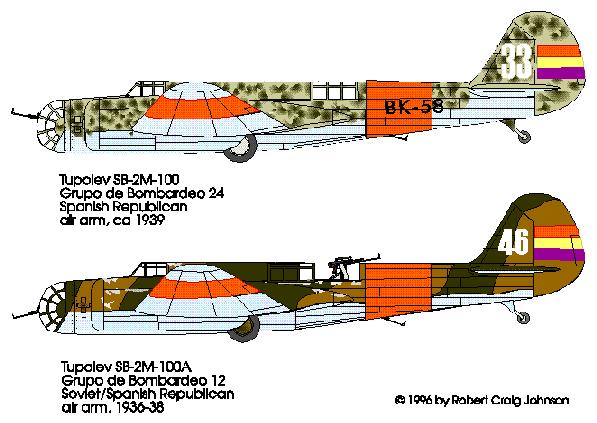
When Andrei Tupolev's SB light bomber appeared in the early months of 1936, it was arguably the most advanced aircraft of its time. Its 255-mph top speed was higher than that of the Dornier Do 17F, the Heinkel He 111B, and the Martin B-10 and roughly equaled that of the Mitsubishi G3M. This, together with a 27,887-ft service ceiling made the airplane all but immune to fighter interception prior to the late Thirties. Unfortunately, the SB was so good that it blinded much of the Soviet air staff to the need for a successor. The fast bomber that proved unbeatable over Spain in 1937 and 1938 found itself outclassed by the Bf 109E fighters that reached the Fascist air force in 1939. The warplane that could easily evade Japanese defenses over the Khalkin Gol and Japanese-held Formosa suffered horrendous losses when Japan's German ally invaded the USSR.

Structurally, the SB was on the cutting edge of aviation technology in 1936. The Tupolev team abandoned the Junkers-type corrugated duralumin skinning that it had used hitherto for a smooth, stressed-skin, semi-monococque structure. Fuselage, wings, and tail were fabricated entirely from riveted, light-alloy strips and stamped or rolled channel sections. There were no drawn tubes or complex forgings to complicate manufacturing or maintenance.
The SB prototype flew with a pair of imported, 730-hp Wright Cyclone air-cooled radial engines. But these soon gave way to 760-hp Hispano-Suiza HS12Ybrs liquid-cooled V12s and their license-built derivatives, Klimov M.100s. Production SB-2M-100s had prominent, car-type radiators and two-bladed, adjustable-pitch propellors. The propellor hubs featured prominent dogs for the truck-driven Hucks starters used by the Red air forces. Exhaust pipes and hot radiator air exited the cowling via a neat slot just aft of the leading edge of the wing. Four wing tanks could hold up to 417 gallons of fuel, but only the inner, 90-gallon tanks were filled in normal service. Four to six 220-lb FAB-100 bombs could be carried nose-up in the internal bomb bay. Fixed, non-retractable skis could be fitted for winter operation.
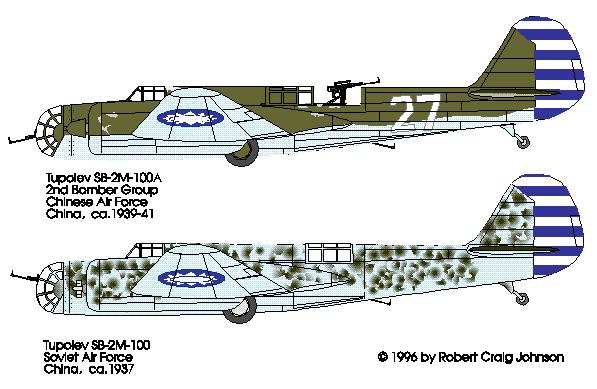
Defensive armament was in some respects well ahead of the state of the art at the time. The mountings showed little improvement over those of the First World War. Two 7.62-mm machineguns fired from vertical slots in the glazed nose. Traverse was very limited. Another ShKAS fired from a ring and post mounting under the sliding canopy of the rear cockpit. A fourth gun was mounted in a hatch in the lower rear fuselage. But the ShKAS machinegun itself was an extraordinary weapon developed especially for aircraft use. Using a special 7.62-mm cartridge, each gun could fire 1800 rounds per minute at a time when most foreign weapons fired 500-800 rpm.
The improved, SB-2M-100A model received uprated, 860-hp M-100A engines and three-bladed propellors with spinners and Hucks dogs, but was otherwise externally similar to the SB-2M-100. The bomb bay could now carry a horizontally stowed 1100-lb FAB-500. External racks could accomodate an aditional 660 lbs of bombs under the wing roots.
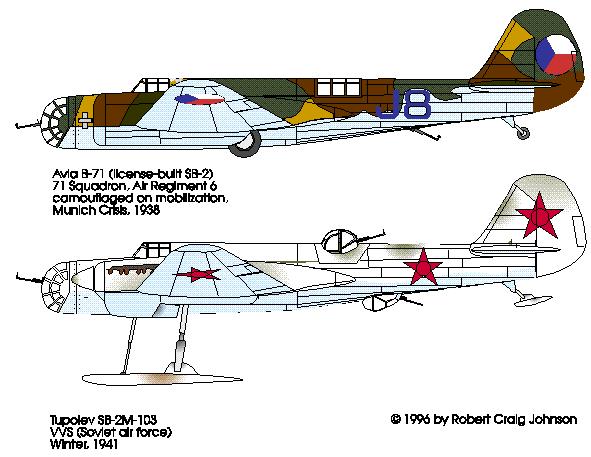
Czechoslovakia purchased a license to manufacture the SB-2M-100A in 1937, just as the Munich Crisis began. The USSR exported 60 aircraft as the B.71, and Avia and Aero built a further 111 in record time, all powered by the Avia-built HS12Ydrs engine. These aircraft had a single gun in the nose and substituted Czech weapons and equipment wherever possible.
The SB-2M-103 (Series 10) introduced further uprated engines, Klimov M-103s with Russian-designed 2-speed supercharger drives. These offered 860, 960, or, eventually, 1100 hp for takeoff. Bomb load increased to over 3000 lbs, and the external racks were plumbed for 90-gallon drop tanks. Emergency, flight controls were added to the navigator's position in the nose (if anything happened to the pilot, the navigator had little chance of bailing out of his narrow, low-drag cockpit). A retractable ski undercarriage replaced the optional fixed skis of the earlier models.
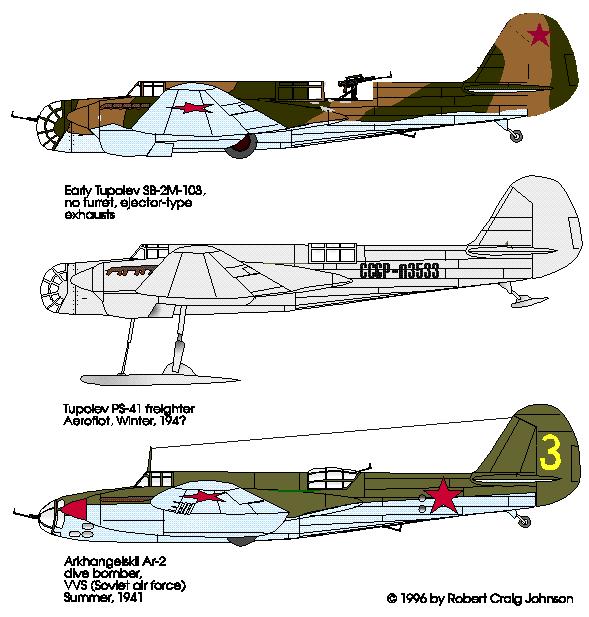
The SB bis 3 (Series 14) received a new engine installation. It dispensed with the car-type radiators of earlier models in favor of a modern, chin-type, ducted radiator. The oil coolers were relocated to the leading edge of the wing. Late-production examples had a glazed gondola mounting a periscopically aimed ShKAS gun in place of the ventral hatch used on the earlier models.
The last major production model of the SB was the SB-2M-103 (Series 18) of 1939. These replaced the dorsal ring mounting and sliding canopy with a semi-retractable MV-3 turret for the single 7.62-mm ShKAS gun.
In 1939, in an attempt to boost the speed and all-around usefulness of the now dated SB, Tupolev's deputy, Aleksandr Arkhangelskii, redesigned the bomber with a smaller wing, a more streamlined fuselage, and a lighter airframe. This went into production in September 1940 as the Ar-2 dive bomber. Level speed increased to an eventual 318 mph, and electrically actuated dive brakes made true diving attacks practical. However, only 200 were delivered before the factory was forced to evacuate beyond the Urals. By the time it re-established itself, the much superior Pe-2 was available in quantity, and no further production was attempted.
The SB was a colorful bird for a Russian. It served in Spain in a variety of camouflage finishes. Russian-flown SBs likewise formed the bulk of the Chinese Nationalist bomber force in the war against Japan. Czechoslovakian B.71s were used as trainers by the Luftwaffe or passed on to Bulgaria and Finland. Demilitarized SBs served as fast transports with Aeroflot, under the designation PS-40 or PS-41. This varied service produced a wide variety of markings, many of which are shown here (note that the serial numbers of the Finnish bomber and the olive drab Chinese airplane are conjectural, though correct in form and style).
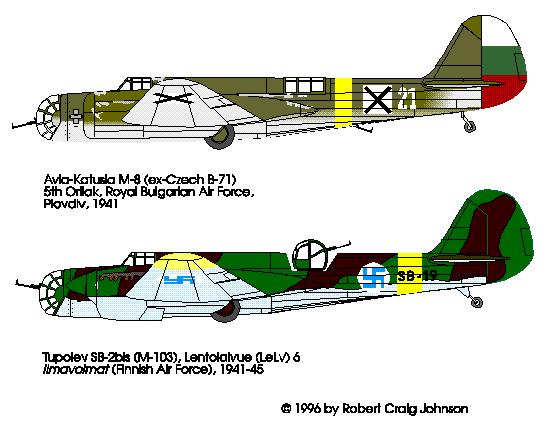
There are two basic kits available for the SB. In 1/72-scale, you are limited to Frog's elderly kit of the SB-2M-100/100A. It has very pronounced, raised panel lines, thick transparencies, and rough-fitting parts. But it offers 2- and 3-bladed propellors, optional skis, and external FAB-100 bombs. It is probably still available under the Russian Novo label. MPM's 1/48-scale vacuum forms are excellent, with good surface and cockpit detail, injection molded parts, and etched-brass detail pieces. Decals are excellent if fragile products of PropagTeam and offer markings for two or more aircraft. Separate kits are available for the M-100 and M-103 variants. The kit for the SB-2M-100 and the Czech B.71 come with Spanish Republican and Czech markings. The SB-2-M-103 (Series 18) kit has Russian, Finnish, and Chinese insignia.
© 1996 by Robert Craig Johnson. Part of a series first published in Eagle Droppings, the Newsletter of the Rocky Mountain Chapter, IPMS/USA.